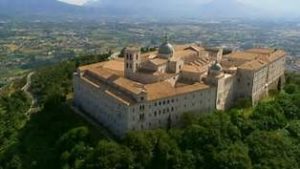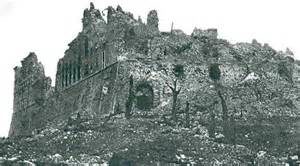Monte Cassino, a Benedictine Abby eighty miles southeast of Rome, is perched high on a peak overlooking the town of Cassino and the surrounding valleys. St. Benedict of Nursia founded it in 524 AD. In early 1944, it was the site of four of the costliest, bloodiest battles of WWII.
In 1943, Field Marshall Albert Kesselring was hand picked by Hitler to command Axis forces in Italy. Anticipating an attack by the Allies after their landing in Salerno, he built a series of defensive lines across “the boot” of Italy to stop the Allied advance north.
The Abby anchored the “Gustave Line,” located in the mountainous area halfway between Anzio and Naples. It was thought to be an observation post for the German Army. Kesselring informed the Allies and the Vatican that he would not occupy the Abby.
Austrian Colonel Julius Schkegel warned the Abby’s abbot about the high probability of the Abby being bombed by the Allies in the coming months. It was arraigned that dozens of works of art be removed to the Vatican to avoid destruction.
On January 17, 1944, the 56th and 5th Divisions of the British X Corps got things started with an assault on enemy forces in the town of Cassino in the valley near the Abby. They fought hard, but were turned back by a tenacious German defense and suffered 4000 casualties.
Three days later, the U.S. 36th Division assaulted. They had to cross areas that were heavily mined and booby-trapped and had no armored support. They ran into the well dug-in 15th Panzer Grenadiers who inflicted 2100 casualties on the 36th.
On February 11th, the U.S. 34th Division gave it a try. The flooding of a nearby river slowed their progress and they had no better luck than the 36th even though they fought fiercely. After two weeks of torrid combat, they were withdrawn, enduring 2200 casualties.
On February 15, 1944, the Allies evidently forgetting Kesselring’s comment that he would not occupy the Abby, dropped 1400 tons of bombs on the structure, virtually destroying it. At the time it was occupied only by a small group of civilians, six monks and their 79-year-old abbot, Gregorio Diamare. They survived by retreating to the deep vaults in the abbey. After the initial bombing, the old abbot led the survivors into the valley, reciting the rosary.
After the air assault, elite members of the German 1st Paratroop Division moved into the rubble and fiercely defended the monastery. The rubble caused by the bombing provided excellent defensive cover.
Over the next several months, further assaults and counter-assaults took place. The town of Cassino and surrounding areas was reduced to rubble. The only part of the Abby to survive the fighting was the crypt of St. Benedict.
By mid-May the Germans had had enough, and withdrew to a defensive position north of the Abby.
Ironically, the commanding officer of the German forces at Cassino was Generallieutant (Maj. Gen.) Frido von Senger und Etterlin. He was a lay member of the Benedictine Order.
The cost of victory to Allies was horrendous. They suffered some 55000 casualties.
Pope Pius XII later issued a statement stating that the bombing was “a colossal blunder…a piece of gross stupidity.”



